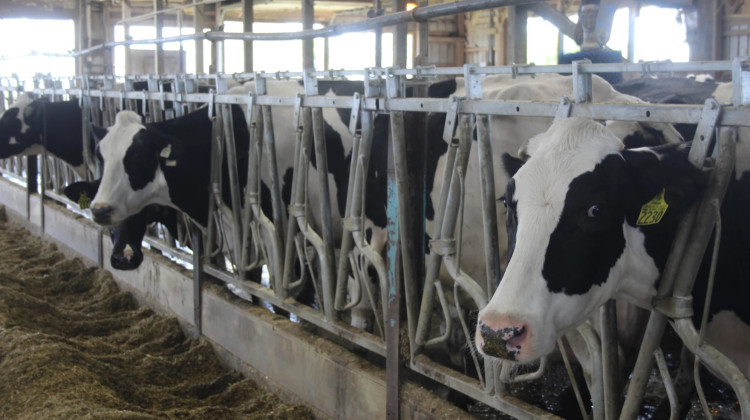
New research suggests that some of the bird flu virus could survive the pasteurization process. But the researchers say we don't know how that translated into real life. For now, health experts affirm commercial milk is safe. The biggest concern right now is raw, unpasteurized milk.
Ben Thorp / WFYIThe H5N1 virus, or bird flu, was found in cows for the first time ever this year. That’s caused concern that infected cows mean the virus could have more opportunities to cross over into humans, which could mean a potentially deadly virus.
A couple of months ago, the FDA said that commercial milk is safe because the pasteurization process kills any living virus. Now, some scientists are saying there is evidence that pasteurization may not be as foolproof as we hope.
Lizzy McGrevy, Side Effects Public Media’s community engagement specialist, sat down with Health Reporter Ben Thorp to talk about the latest research.
This transcript has been edited for length, style and clarity.
Lizzy McGrevy: So Ben, what’s it like to be a full-time milk reporter?
Ben Thorp: Honestly? A lot more exciting than I would have anticipated.
McGrevy: So, Ben, maybe start by talking about a recent letter to the New England Journal of Medicine which found that some virus could be surviving the pasteurization process. What’s happening there?
Thorp: So, I think it’s important to underline here that this is an experiment conducted in a laboratory setting. Scientists I spoke to about this letter said, ‘Hey –– we don’t know how replicable something like this is outside the lab.’
But the gist is this: Researchers spiked raw milk with high levels of the bird flu virus also known as H5N1 and then put it through two pasteurization processes. One method involved heating up milk to 63 degrees Celsius for 30 minutes. The other method was just 15 seconds at 72 degrees Celsius.
I think it’s worth noting that according to the International Dairy Foods Association, 15-second pasteurization at 72 degrees Celsius is the most common process in the U.S.
McGrevy: Ok, Ben, why do we need to know the different methods of pasteurization?
Thorp: Well, what researchers found is that for the 15-second method, there were still detectable levels of virus in milk.
In fact, researchers say there was still detectable virus up to even 20 seconds at 72 degrees Celsius. That means that there’s a chance that even after the pasteurization process some live virus could be surviving.
Researchers did find that the 30-minute method for pasteurization was effective at killing the virus and that “standard bulk pasteurization of 30 minutes at 63° C has a large safety buffer.”
But, again, we don’t know how these lab tests might translate into the real world.
It’s also worth saying the U.S. Food and Drug Administration has continued to affirm the safety of retail milk. The FDA sampled milk earlier this year, and while they did find evidence of fragments of H5N1 in retail milk, there was no live virus.
McGrevy: Ok, so that’s concerning –– what’s next?
Thorp: So, experts behind the letter say they want more research into H5N1 in dairy production. They want to see whether their experiments are really replicable.
There’s so much we don’t know about this virus right now, including what dose could infect humans through drinking it.
Some experts say they aren’t worried about retail milk, however.
“I think it's good information to have to understand the characteristics of pasteurization, with this particular virus,” said Dr. Amesh Adalja, a senior scholar at Johns Hopkins Center for Health Security. “But the bigger threat to me comes from unpasteurized milk, not just for avian influenza, but for a whole host of pathogens that are in unpasteurized milk.”
More broadly though, Adalja said there isn’t enough being done to track the virus and understand how widespread infections of cows –– and people –– really are.
“I don't believe that this strain of H5N1 is going to be the strain of avian influenza that causes a pandemic. However, it is a very good trial run that we're failing,” he said.
The FDA is trying to reduce the sale of raw milk. The department put out a letter earlier this month underlining that while the FDA does not approve the sale of raw milk for human consumption, some states do.
Their message was basically: Hey, help us communicate to people that in the midst of this outbreak it is maybe not the time to be drinking raw milk. They also called on states that permit the sale of raw milk to use regulatory authorities to try and stop those sales, especially in areas where infected herds have been identified.
McGrevy: Well Ben, looking forward to talking with you about milk again in a couple of weeks.
Thorp: Hopefully not too soon.
The Checkup by Side Effects Public Media is a regular audio segment on WFYI's daily podcast, WFYI News Now.
Side Effects Public Media is a health reporting collaboration based at WFYI in Indianapolis. We partner with NPR stations across the Midwest and surrounding areas — including KBIA and KCUR in Missouri, Iowa Public Radio, Ideastream in Ohio and WFPL in Kentucky.
 DONATE
DONATE








 Support WFYI. We can't do it without you.
Support WFYI. We can't do it without you.